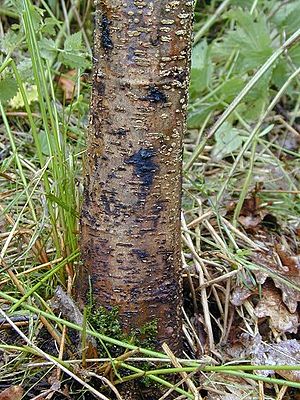Alder death
| Alder death | ||||||||||||
|---|---|---|---|---|---|---|---|---|---|---|---|---|

Symptoms of alder death: black-brown weeping spots |
||||||||||||
| Systematics | ||||||||||||
|
||||||||||||
| Scientific name | ||||||||||||
| Phytophthora alni | ||||||||||||
| Brasier & SA Kirk |
The conical death is a disease of alder by infestation with the Scheinpilzart Phytophthora alni of the genus Phytophthora within the oomycete ( Oomycota ). The disease symptoms have been observed in alder trees since the end of the 20th century. The infestation leads to root or neck rot. Infected trees usually die after a few months. Often entire wood fringes are affected. Among the alder is especially the black alder ( Alnus glutinosa ) concerned, the alder dying but was also gray alder ( Alnus incana ) and the Italian alder ( Alnus cordata observed). Alder deaths have so far been limited to Europe and are particularly common in southern England. The disease was first detected in Germany in 1995. Since then, finds have been reported from several federal states.
Symptoms
Infested alders form only a few and small leaves, which are usually unusually light (greenish-yellow) and are thrown off early. There are also dead branches in the crown.
Characteristic of Phythophthora alni are black-brown weeping spots, which form at the trunk and later expand upwards. As the disease progresses, the spots grow together and form so-called tar spots , from which the tree bleeds profusely.
Under the bark, dark brown to reddish brown discolorations stand out sharply from the otherwise light tissue. The diseased tissue extends into the xylem so that the crown can no longer be adequately supplied with water and nutrients.
Spread
The spread of the alder phythophthora has not yet been fully explored. Like other Phytophthora species, it can be assumed that it spreads over long distances through watercourses, which is also explained by the flagellated zoospores. The phenomenon can not only be observed in watercourses, but also inside the stand.
In general, waterlogging and flooding at low to moderate temperatures offer ideal conditions for the pathogen. Therefore, the mushroom is particularly active in autumn and spring. There is evidence to suggest that acidic pH levels favor the occurrence of alder death. The survival of unfavorable climatic conditions has not yet been fully clarified. However, the formation of permanent spores and the temporary feeding of dead organic material in dead alders are possible.
Infection of the alder
The pathogen can infect alder trees through wounds on the roots and trunk. Penetration through the natural intercellular openings ( lenticels ) on the trunk and via the fine roots cannot be ruled out. Strongly changing water levels in the area of the rhizosphere can promote infection via the roots, since injuries in the root area can easily occur. If the pathogen has penetrated to the root or trunk base, it spreads quickly in the infected tree and predominantly colonizes the cambium and the adjacent tissue of the phloem and xylem . The infected tissue turns brown and dies, which interrupts the supply of water and nutrients to the tree.
The disease can take very different courses. Premature death after just a few months is possible. However, the disease does not necessarily have to lead to the death of the tree. Infested trees are, however, severely weakened and therefore susceptible to further pathogens and pests.
Combat
Chemical control is excluded due to legal regulations. Antagonists are not yet known. To combat the extinction of alder trees, it is therefore only possible to cut down infected trees (including removing the roots) and completely destroy the wood. With new plantings, natural regeneration should be used or seeds from different origins should be used. Areas on which Phythophthora alni has already been detected and areas with waterlogging should also be avoided in order to minimize the risk of infection.
swell
- ↑ G. Hartmann: Neck rot of the black alder (Alnus glutinosa) - a previously unknown fungal disease caused by Phytophthora cambivora. In: Forst and Holz 50 , pp. 555-557 (1995), ISSN 0932-9315 .